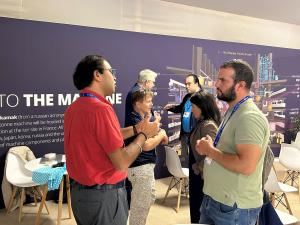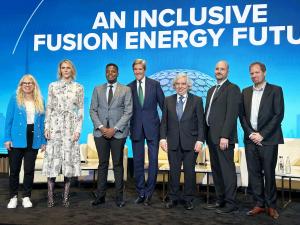Fusion and climate—the conversation continues
Has fusion arrived on the big stage? It certainly seems so after the world summit on climate change that was recently held in Dubai, the iridescent hub of the United Arab Emirates. And promotion for this new source of energy came from somewhat unexpected quarters.
The rules of the COP foresee that each party has three minutes to deliver its statement. A procedure that lasted two days, as a long line-up of heads of state and heads of government—including French President Emmanuel Macron, German Chancellor Olaf Scholz, Italian Prime Minister Giorgia Meloni and United States Vice President Kamala Harris—took to the stage. But it was Andrej Plenković, Prime Minister of Croatia, who for the first time ever at a COP conference addressed the potential of fusion energy in an official statement. "The IFMIF-DONES project, a joint effort of Croatia and Spain, explores ways to harness fusion—a clean nuclear energy, akin to the power that fuels the Sun—within a few decades."
The buzz about fusion energy as a potentially game-changing contribution to mitigating the effects of climate change continued throughout the conference. The announcement by United States Special Presidential Envoy for Climate John Kerry on 5 December of an international engagement plan for fusion energy added real momentum to this perspective. "There is the potential in fusion to revolutionize our world," Kerry said, and added that "fusion can be a critical piece of our energy future, along with wind and solar, nuclear fission and geothermal energy."
Presenting the strategy as a call to action, Kerry laid out five key areas that will help realize the promise of fusion technology: R&D; supply chain and marketplace; regulation; workforce; and education and engagement. United, and with determination he said, "we can harness the remarkable power of atoms to build a clean energy future."
Already in the early days of COP28, which was held from 30 November to 12 December, it became clear that fusion energy is increasingly being recognized as a viable if long-term option for a clean energy future and a solution for the climate change crisis. A panel discussion on 1 December kicked off the many fusion energy-related events at COP28 that looked at the way ahead in the field. Rafael Mariano Grossi, Director General of the International Atomic Energy Agency (IAEA), Christofer Mowry, CEO of Type One Energy and Chair of the Fusion Industry Association Board, and Laban Coblentz, ITER Head of Communication, all agreed on the need for global collaboration involving the private sector and public initiatives.
Grossi reminded the audience of the initiative announced at the IAEA Fusion Energy Conference in October to enhance fusion energy collaboration—the World Fusion Energy Group. "We will bring everybody together at the IAEA. The World Fusion Energy Group will be the big tent where we can all fit in and share experiences."
ITER, together with supporters and collaborators such as Simon Woodruff from Fusion Energy Insights, had set up a stand in one of the conference's four thematic hubs on energy. The diversity of visitors to the ITER pavilion—scientists, political decision-makers, climate activists, students, journalists—made for interesting discussions.
Across from the ITER pavilion, the non-governmental organization (NGO) Clean Air Task Force ran a panel discussion on 9 December on fusion energy's potential for providing a transformative source of zero-emission electricity and energy, helping to drive decarbonization, energy security, and energy access around the world. Communication as a means of involving communities in the development of fusion energy was highlighted by Phil Larochelle of Breakthrough Energy Ventures. "We need to get better at telling the story of fusion," he said, while explaining: "People need to understand that it's the original energy source from which nearly every other energy is derived. We also need to highlight the tremendous progress fusion has made over years."
Ralf Kaiser of the Abdus Salam International Centre for Theoretical Physics (ICTP) advocated for the involvement now of the global south in the development of fusion energy. Considering that many future power plants will need to be built in the developing world, these countries should have a voice and be involved in the governance of fusion energy, he opined.
It seemed as if some key themes kept reverberating throughout the conference and resurfacing in various discussions. Fusion regulation, social licensing, diversity, inclusion and communication to name a few—all of these themes were also touched on during the panel discussion organized by the NGO Energy for the Common Good at the ITER pavilion.
And let's not forget that the younger generations have a big stake in the overall issue of climate change. As one Turkish high school student said when visiting the ITER stand, "Our future is at stake so we need to play a major role in addressing climate change."
After this climate summit, the bar of expectations for fusion energy has been raised by a few notches. The eyes of the world will be watching as the fusion community sets out to put into practice the many ideas that were raised and discussed at COP28.
To be continued at COP29 in Baku, Azerbaijan ...
See some impressions from the COP28 experience in this short video.



